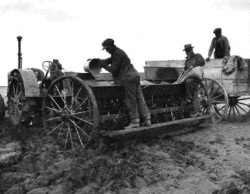THE INDUSTRIAL REVOLUTION
HIGH FOOD DEMAND
Before the Industrial Revolution, humans gathered their food supply by either working the fields or hunting animals all by hand for thousands of years. The Industrial Revolution completely modernized how food was produced, treated, packaged and transported throughout Europe.


Cause:
With the new innovations of the Industrial Revolution, new ways to produce food supplies were created with mankind’s new technological advances, to make things easier. These changes in farming allowed greater supplies of better quality food to be created with less manpower. New and improved items such as fertilizers and seed drills were introduced to create working almost non-existent for most Europeans.
With these new ways to produce food, new ways to keep the food fresh and edible for long periods of time as the food supply would get larger.
Effect:
The new innovations added to farming, such as the revolutionary seed drill (that allowed seeds to be easily planted deep into the Earth), the horse hoe (which allowed the seeds to be planted at a certain height due to a horse pulling the hoe along the ground) and a revolutionary four-course crop rotation system (that allowed good grounds keeping and a steady food supply for essentially for the entire year) were, needed and great, caused many to fall into unemployment due to machines replacing their now non-existent jobs. Another ingenious effect by the large unemployment of previous field workers was that they then became the workers in the factories and manufacturing plants built by entrepreneurs.
These large supplies of food cause the entire cost of food to drop, causing cheap foods such as canned meats to come to popularity as a cheap and belly filling food. These foods needed to be able to stay fresh, so things such as chemical alteration in food suddenly became present in a bid to advertise food that stayed fresh for longer times.
These foods were also distributed across the country, which meant that some trains (the major transportation method at the time) had to become cargo trains, transporting needed supplies along supply routes across Europe and across oceans via the newly developed steamboats.
Long Term Effect:
These new innovations introduced allow us today to eat foods from across the world, still fresh. Better ways of storing, manufacturing and transporting food were created, all of which can clearly originate from the simple machines created in the Industrial Revolution. We are also able to feed our own countries because of the work done by farmers, who use techniques and machines created by those same entrepreneurs and inventors in the Industrial Revolution.
These new ways of producing food also allow countries today to make money exporting and importing the food the make to other countries. The economy (and livelihood) of many countries rely on being able to import food to eat/sell and exporting food to make money. Without these abilities, many countries would essentially starve to death.
